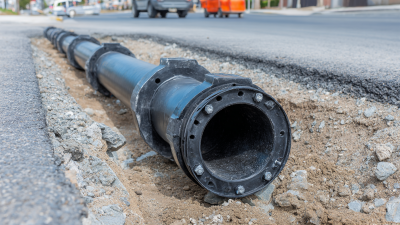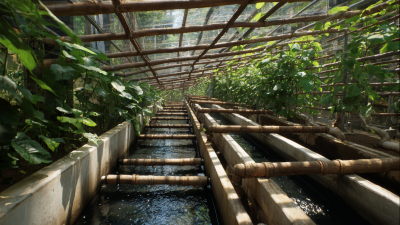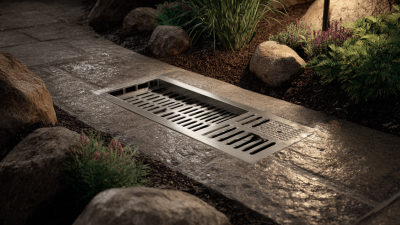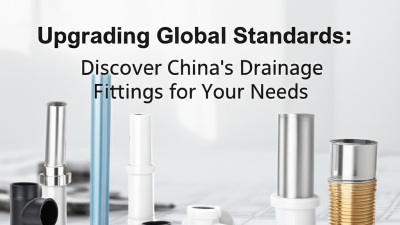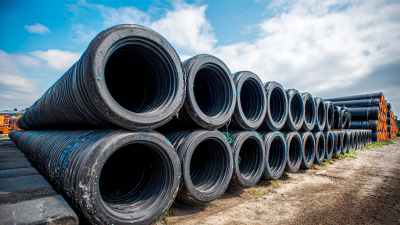When it comes to effective water management and drainage solutions, perforated pipes play a vital role in a variety of applications, from agricultural fields to urban infrastructure. According to a recent report by the National Association of Home Builders, the demand for perforated pipes is projected to grow significantly, with a compound annual growth rate of 4.5% over the next five years. This increase underscores the importance of selecting the right perforated pipe that meets specific project requirements.

With numerous options available in terms of material, size, and hole configurations, making an informed choice can optimize performance and longevity. This essential checklist will guide you through the key considerations to ensure you select the most suitable perforated pipe for your needs, ultimately enhancing efficiency and sustainability in your drainage solutions.
When selecting the right perforated pipe for your needs, several key factors should be carefully considered. First and foremost is the material of the pipe. Common options include PVC, HDPE, and stainless steel, each offering unique benefits suited for specific applications. For instance, PVC is lightweight and resistant to corrosion, making it ideal for drainage systems, while stainless steel provides higher durability for industrial use.
Another critical factor is the perforation pattern and size. The design of the holes affects water flow and filtration efficiency. A larger hole size may facilitate quicker drainage but can also allow more sediment to pass through, potentially clogging downstream systems. Conversely, smaller holes can improve filtration but may reduce flow rates. Understanding the intended application will help in determining the optimal size and pattern for your perforated pipe.
Finally, consider the intended installation environment. Factors such as soil type, moisture levels, and any potential chemical exposure should influence your choice. For example, if the pipe is to be installed in acidic soil, opting for a more resistant material like HDPE might be necessary to prolong the pipe's life and effectiveness. By carefully evaluating these elements, you can select the most appropriate perforated pipe for your specific requirements.
 When selecting the right perforated pipe for your project, understanding the different materials available is crucial. Perforated pipes are commonly made from PVC, HDPE, and metal, each offering unique benefits. According to a report by the American Society of Civil Engineers, HDPE pipes are increasingly popular due to their high corrosion resistance and lightweight nature, which can simplify installation processes. Conversely, metal pipes, often made from galvanized steel, are favored for their durability and strength but may be more susceptible to corrosion if not properly maintained.
When selecting the right perforated pipe for your project, understanding the different materials available is crucial. Perforated pipes are commonly made from PVC, HDPE, and metal, each offering unique benefits. According to a report by the American Society of Civil Engineers, HDPE pipes are increasingly popular due to their high corrosion resistance and lightweight nature, which can simplify installation processes. Conversely, metal pipes, often made from galvanized steel, are favored for their durability and strength but may be more susceptible to corrosion if not properly maintained.
Tip: Always consider the environmental factors where the pipe will be installed. For acidic or alkaline soils, PVC or HDPE may provide a longer lifespan compared to metal options, which can degrade over time.
Another aspect to consider is the perforation pattern and size, which can significantly affect water flow and soil aeration. Studies suggest that a larger hole with optimal spacing allows for better drainage performance, making HDPE a favored choice for agricultural applications.
Tip: Consult with a professional to determine the best perforation size based on your project's specific drainage needs and soil conditions to ensure effective functionality.
When selecting a perforated pipe for drainage systems, understanding the implications of hole size and spacing is crucial. The size of the holes directly affects the flow rate of water; larger holes can facilitate quicker drainage, making them ideal for areas prone to heavy rainfall or swampy conditions. Conversely, smaller holes may prevent sediment and debris from clogging the pipe, thereby enhancing long-term functionality in environments with finer materials. Therefore, evaluating the site’s specific drainage needs is key to determining the appropriate hole size.
In addition to hole size, the spacing between holes plays a critical role in drainage efficiency. Closer spacing can ensure more uniform water distribution along the length of the pipe, which is especially beneficial in situations where consistent water flow is necessary. However, excessive hole density can weaken the structural integrity of the pipe and lead to potential failure under various environmental pressures. Thus, striking a balance between hole size and spacing will lead to an optimal drainage solution tailored to specific site conditions, providing both immediate and long-term benefits.
This chart illustrates the importance of different hole sizes and spacing on drainage efficiency for perforated pipes. The data shows the relationship between hole size, spacing, and drainage capacity.
When selecting a perforated pipe, understanding the installation techniques is crucial for ensuring optimal performance. Proper installation directly influences the pipe's efficiency and longevity. One effective technique is to ensure the pipe is laid on a level substrate to facilitate even drainage. This helps to prevent any blockages and ensures that water flows freely through the perforated sections.
Another tip involves choosing the right backfill material. Using clean, coarse gravel can promote better drainage compared to finer materials like sand. This choice minimizes the risk of clogging the perforations and allows water to penetrate effectively. Additionally, consider the angle at which the pipe is installed; a slight incline can aid in directing water flow toward the intended drainage area.
Lastly, always pay attention to local regulations regarding installation depth and distance from structures. Adhering to these guidelines not only ensures compliance but enhances the system's overall effectiveness. Proper care and attention during the setup phase will lead to a more resilient and efficient perforated pipe system that meets your specific needs.
When budgeting for your perforated pipe needs, it’s crucial to consider both upfront costs and long-term benefits. According to a report from the National Association of State Procurement Officials (NASPO), the cost of perforated piping can range from $1 to $3 per linear foot, depending on material specifications and diameter. Understanding these expenses will help you assess the overall financial commitment required for your project.
Tip: Always request multiple quotes and compare the material quality offered by suppliers. The cheapest option may not always provide the best long-term value, especially if you factor in installation costs, maintenance, and durability across various environments.
Moreover, think about the application. For example, permeable surfaces in agricultural drainage applications may necessitate specific pipe features, impacting the initial investment. A recent report by the American Society of Civil Engineers (ASCE) noted that improper selection of drainage solutions could lead to increased maintenance costs of up to 20% over time.
Tip: Always evaluate the total lifecycle cost, which includes expenses for installation, maintenance, and potential repairs, to make an informed decision regarding your perforated pipe selection.

